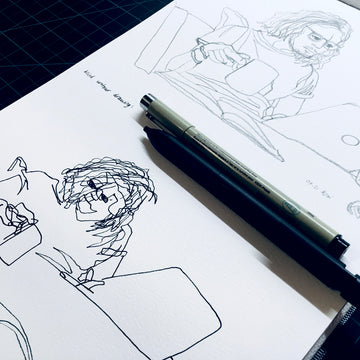 Sometimes, practice can seem daunting, or perhaps you feel there aren’t enough hours in the day to squeeze any art into your day. So how about trying a simple exercise to improve your observation skills? It’s quick, easy to understand, and can be a good “warm-up” before doing more serious work.
Sometimes, practice can seem daunting, or perhaps you feel there aren’t enough hours in the day to squeeze any art into your day. So how about trying a simple exercise to improve your observation skills? It’s quick, easy to understand, and can be a good “warm-up” before doing more serious work. This will be a quick introduction to blind contour drawing, and to practice picking out the essentials through self-imposed restrictions.
Contour Drawing

In a nutshell, contour drawing is using basic linework to draw the essential outlines and contours of a subject. With this method, you’ll be more focused on the shape and weight of the subject rather than its shading or small details.
It can end up looking quite minimalistic, or even abstract, but it’s no less expressive because all of the subject’s information has been condensed and compressed into simple linework.
You can practice this yourself by first choosing a subject (still-life or a live subject will work), then start drawing the outlines on a piece of paper in pencil or pen. After you’re done with the outlines, add some contour lines – basically, lines that divide the basic tones, shapes, and/or form of your subject.
The key here is to spend most of your time looking at your subject than your paper and to go as slowly as possible. This is so you can train your observation skills, and draw what you see, not what you assume the subject should look like.
If you’re not sure what the final drawing should look like, feel free to look up some contour drawings online or refer to the image above!
Tip: If you find that you’re tempted to start erasing things or add too many details, throw your eraser across the room and try to keep your eyes focused on the subject. Remember, go slow!
You can imagine the tip of your pencil as an ant crawling around the outlines of your subject. Another option would be to do a continuous contour drawing, where you don’t even lift your pencil off your paper until you’re done.
Going in Blind

Once you’ve got a good idea on how to do a contour drawing, let’s try the blind version, shall we? Don’t worry – it's not as scary as it sounds!
The only difference between this and regular contour drawing would be to not look at your paper at all while you’re drawing. You don’t want to blindfold yourself, because that defeats the purpose of this exercise, which is to improve your observational skills and your hand-eye coordination.
What you want to do is to “feel” your way around the subject and your piece of paper, and gauge the distance and contours from just the connection between your eyes and your hand and arm. It’s going to be difficult on your first time around, but try to make bold, confident strokes with your pen or pencil!
Bonus tip: If you’re too tempted to look down, you can block your vision from your drawing by poking your pencil through the middle of a sheet of paper and holding the pencil from underneath the paper. Also, I recommend doing a continuous line for this practice, as it helps you keep track of how large your drawing is.
You can look down at your drawing once you’re finished to see how it turned out. If you find that you’re focusing too much on your fear (of making a “mistake”, or otherwise), feel free to set yourself a time limit.
Remember, this is just a practice, and the aim is to get more comfortable with simple linework to convey the subject’s form in an expressive way.
Practice, Practice, Practice

Once you’re more comfortable with blind contour drawing, try switching it up a bit. Did you use a pencil? Try doing it in pen. Was your subject too simple? Try something more difficult.
If you want to practice using line weight to bring emphasis your subject’s depth and mass, try using a brush pen or a paintbrush with paint, and vary your line width where heavier parts or parts that are closer to the foreground have a thicker line, while areas in the background or are lighter, in general, have thinner lines.
There are many ways to practice, so feel free to experiment and have fun! Only you know what you need to work on, so make your practice time work for you (and not the other way round!).
Have you tried any kind of contour drawing before? What’s the one thing you can work on to improve your lines? Feel free to let us know in the comments below!
You can find more of Nicola Tsoi’s work on Instagram.


